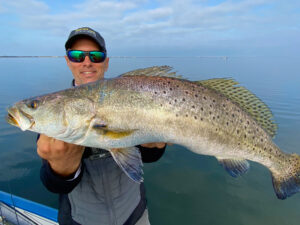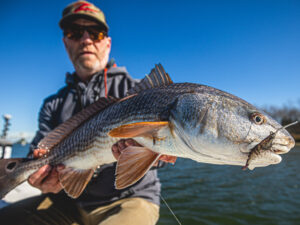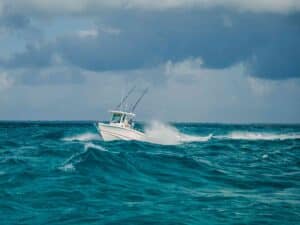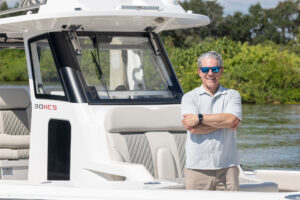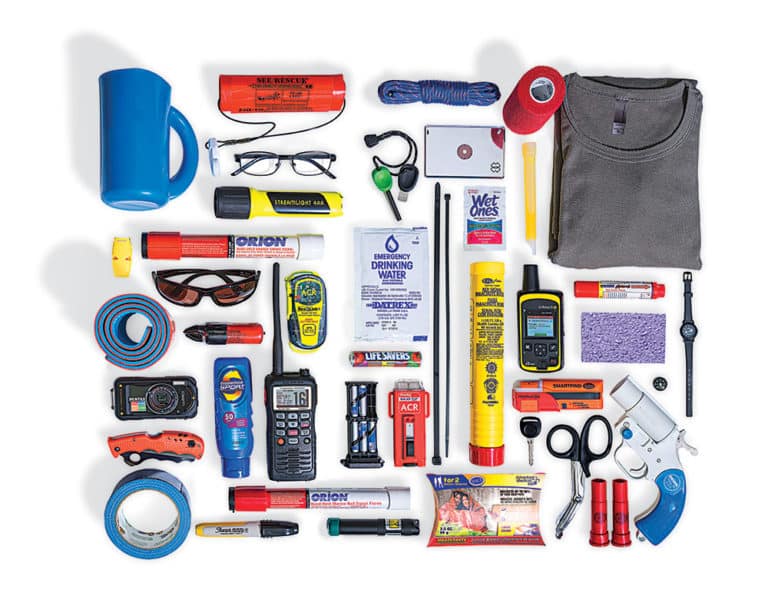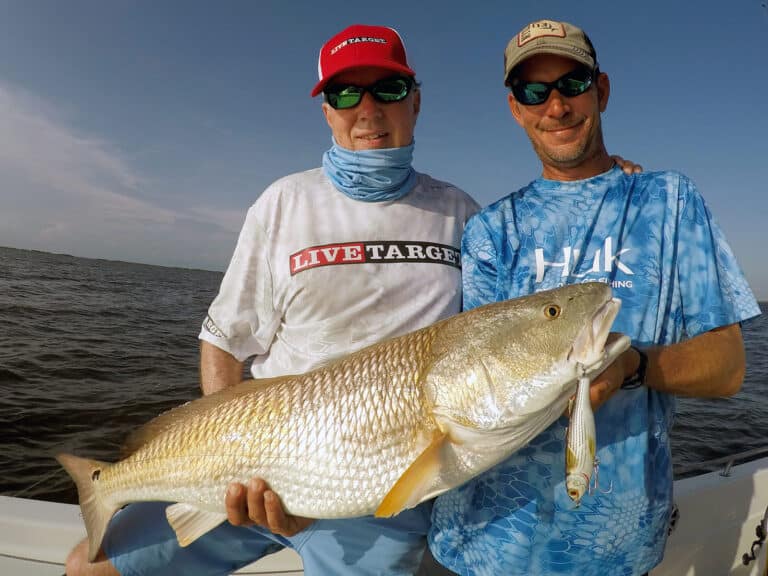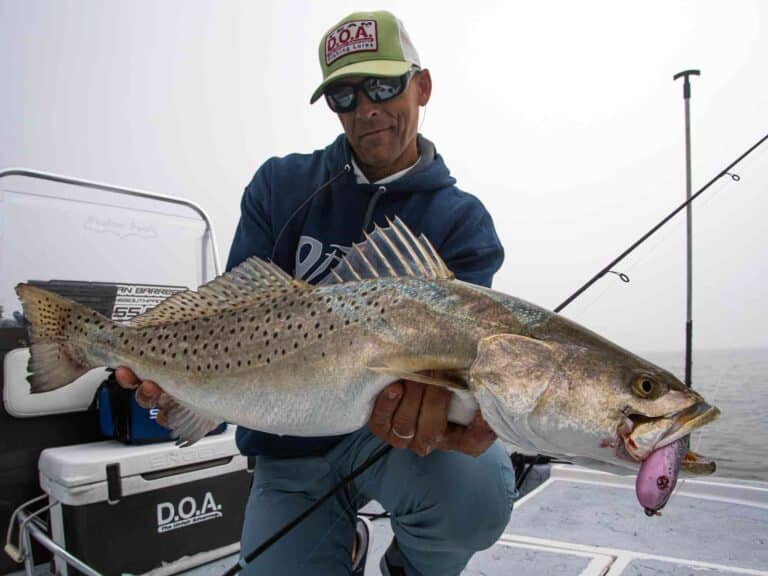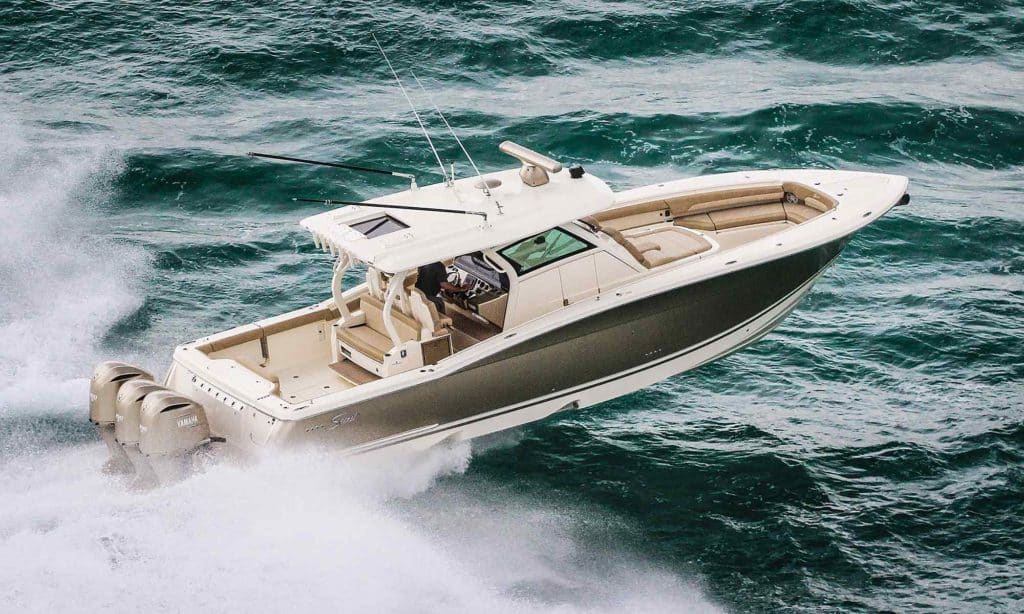
I was first among our crew of six to arrive at the marina in St. Petersburg, Florida, or so I thought. My test boat, the Scout 380 LXF, glimmered in the morning light, with a trio of metallic-gold Yamaha F350 outboards painted to match the dazzling accent color of the epoxy-infused double-stepped hull.
“That’s some bling,” I murmured to myself while admiring the boat’s classic lines. Presently, James Pate, Scout’s southeast sales manager, emerged from inside the center console of the 380.
“When did you get here?” I asked, slightly startled, as I boarded via the swim platform and transom door in the starboard quarter.
“Last night,” Pate answered. “I slept in the cabin. It’s pretty comfortable.”
Comfy Combo
That didn’t surprise me at all; Scout has built a reputation for creating boats that combine the highest level of luxury with serious fishing features. With 6 feet 4 inches of headroom, the console cabin offers ample evidence of this combination. Stepping down through the companionway on the portside, I found a master berth forward that sleeps two but will convert to a pair of facing settees. Large port lights on both sides ushered in plenty of light. I spied a flat-screen TV forward in the cabin. Dark wood flooring added a classy interior touch to the cabin of my test boat, while a rack for vertical stowage of five fishing rods recessed into the starboard bulwark served as a strong reminder that this is indeed a fishing boat.
In the aft starboard corner, an enclosed head compartment featured appointments such as a permanent marine toilet, shower, sink, faucet, mirror and faux-granite counter surfaces. A galley in the aft port corner lets you prep a meal amid wood-veneer cabinetry, a faux-granite countertop, an electric cooktop, a microwave, a drawer-style fridge and a sink.

Innovative Rod Stowage
I emerged from my inspection to find that the other four members of the crew had arrived, including Capt. Tyler Kapela, our guide for the day; Casey Smith, of the Viage Group, the Scout dealership in St. Pete; along with guests Peter Harper and Jeff Trosclair.
We placed five of our fishing rods in the optional rack on the aft edge of the hardtop and found it super easy to reach, thanks to an ingenious design. The rack pivots downward on electro-hydraulic rams to stow and retrieve your sticks. Lowering the rack also allows you to deploy the optional SureShade from the aft edge of the hardtop when you want relief from the sun’s heat. We also stowed rods in the seven gunwale rod holders across the back of the transom
I joined Kapela as he used the Yamaha Helm Master joystick control to push off the dock, and was again impressed with the combination of comfort and angling amenities. Three-across bucket seats cradled each occupant, with fold-down armrests and plenty of leg support. Individual flip-up bolsters transform them to leaning posts for standing at the helm. A trio of 16-inch Garmin GPSMap 7616xsv multifunction displays across the metallic-gold dash brought to mind an Imax theater, but these screens would help lead us to a real-life fishing adventure.

One and Done
“We’re headed to a little wreck about 7 miles offshore,” Kapela said, as he advanced the throttles. We cruised across the waters of Tampa Bay and out Egmont Channel at 4,000 rpm and about 30 mph, but had a stop to make before heading offshore. The wraparound tempered-glass windshield blended seamlessly with the integral hardtop and protected us from wind blast.
Kapela turned right out of the channel and pulled back the throttle at the end of Potter Pier on Mullet Key, where scores of seabirds were diving on massive schools of pilchards. With one throw of his cast net, the guide plugged the 100-gallon livewell in the transom of the Scout 380 LXF with wriggling pilchards. The bait system performed exceedingly well. Nary a pilchard bit the dust before its time.
“Let’s go fishing,” Kapela said, as he put the boat on a course for one of his favorite wrecks.
To make sure everyone had a seat, Pate performed some magic with the optional hideaway entertainment center abaft the helm seating. With the push of a button, the entertainment center rotated to convert to mezzanine seating with an extended footrest. Wow! We then deployed the transom bench seating, and our crew suddenly had plenty of places to sit.
Gyro-Stabilization
Despite a 2- to 3-foot chop on the starboard beam, the ride out was smooth and stable, thanks to the 380’s deep-V hull with an LOA of 38½ feet and a beam of slightly over 12 feet. Also working in our favor was an optional Seakeeper 5 gyrostabilization system, powered by a Fischer Panda 8 kW diesel generator. The Seakeeper eliminated side-to-side movement while underway.
The gyro also rendered the deck more comfortable as Kapela pulled back the throttles to idle and circled to pinpoint his spot with the fish finder. As the captain reconnoitered the wreck, I moved forward along the wide walkways to check out the topside bow accommodations, which included an inviting lounger for two ahead of the console and wraparound seating at the forepeak. A motorized table tucks into the deck when not in use, but elevates to create an expansive sun lounge (with an additional upholstered pad) or ascends even farther to serve as a dining table.
The captain found the wreck, then motored upwind as Smith manned the anchor. The 380’s in-stem anchor chute/roller and Lewmar vertical windlass made easy work of mooring.

Hookups Aplenty
As soon as the first live baits hit the water, rods began to bend. At first it was small kingfish, then larger kings, a few big amberjack and finally a couple of monstrous goliath grouper, with a smattering of bonito and Spanish mackerel thrown in for good measure.
Through all of the action, I marveled at the amount of room afforded to our crew of six as we cast and battled fish in the aft cockpit. Coaming pads that encircle the interior cushioned our legs as we fought fish, and the tuna door on the port side of the cockpit allowed Kapela to more easily and safely release the goliaths.
After catching so many fish, the deck grew a bit slimy, so we used Scout’s unique washdown system, which coils hoses in the aft uprights of the hardtop frame — raw water in one, fresh water in the other. A quick tug on the hose and it quickly recoils into position.
Read Next: 15 Top Center Console Boats: 26 to 30 Feet
Numbers Game
After four hours, our arms were too sore to keep fishing, so we headed in to gather performance data. I took the helm on the run back and turned off the Seakeeper to see how the boat would perform without this feature. The hull sliced through the waves with ease, and there was not a single bump or thud. The Yamaha Helm Master power steering offered precise handling.
With a crew of six, 100 gallons of water in the livewell, 51 gallons of fresh water and 160 gallons of fuel, the 380 LXF jumped on plane in five seconds and reached 30 mph in 10 seconds. Turning 19-inch-pitch propellers on the outside and a 21-inch-pitch prop on the center motor, the triple Yamaha F350s propelled the boat to a top speed of 55.1 mph at 5,800 rpm, where the engines drank 97 gallons per hour for 0.57 mpg.
The Scout achieved its best fuel efficiency at 4,000 rpm and 30.9 mph, where the outboards consumed 39 gph for 0.79 mpg. That equates to a cruising range of more than 300 miles based on the 404-gallon fuel capacity.
Ultimately, the Scout 380 LXF blends practical innovation, luxury and fishing features in a boat that draws admiring looks from anglers and nonanglers alike. And that makes this boat an easy one to love.
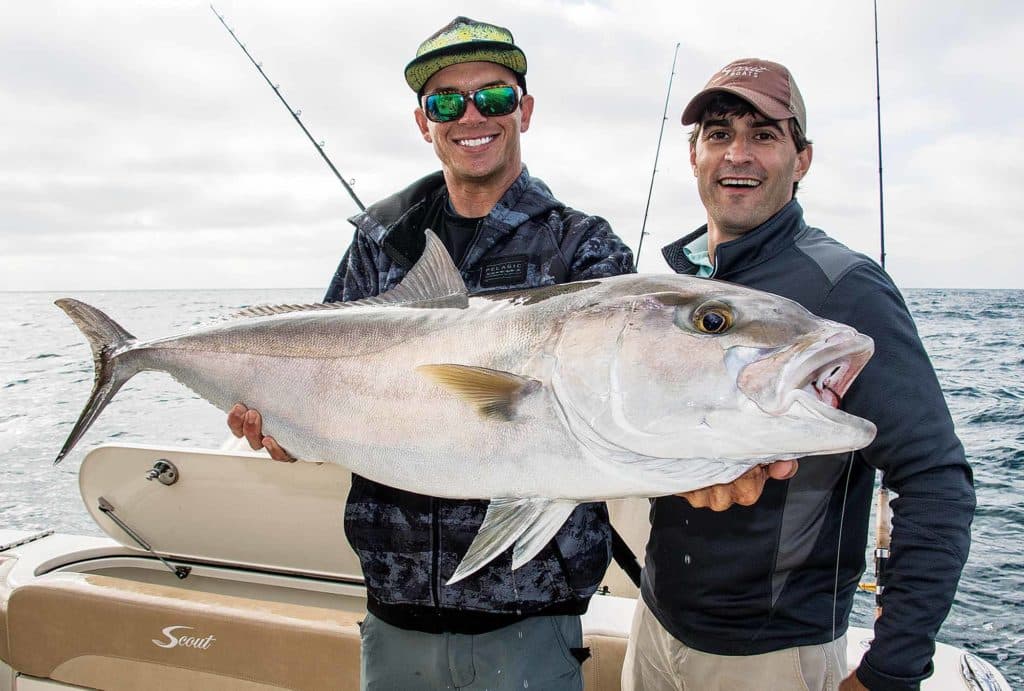
Performance
Power: Triple Yamaha F350s
Load: 160 gal. fuel, 100 gal. water, six crew
Top Speed: 55.1 mph @ 5,800 rpm
Time to 30 mph: 10 sec.
Best MPG: 0.79 @ 30.9 mph (4,000 rpm)
Hull
LOA: 38 ft. 6 in.
Beam: 2 ft. 1 in.
Deadrise: 20 deg.
Dry Weight: 14,500 lb. (w/o engines)
Draft: 2 ft. 3 in
Fuel: 404 gal.
Max Power: 1,200 hp
MSRP: $883,526 (as tested)
Scout Boats
Summerville, South Carolina
843-821-0068
scoutboats.com

